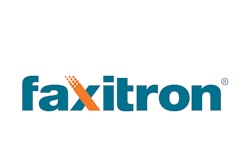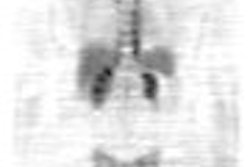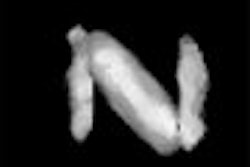A widely used and successful technique in the breast imagers' armamentarium is stereotactic biopsy, particularly in cases of suspicious or indeterminate calcifications. But the procedure may be less valuable if it isn't partnered with a specimen x-ray to determine if a calcification was retrieved and, subsequently, whether the lesion is malignant.
A group from the California Pacific Medical Center in San Francisco compared the diagnostic yield of cores with and without calcifications on specimen radiographs. They found that calcium-containing cores may provide a superior sample for pathological evaluation.
In addition to poor sampling, another potential hazard of breast biopsy is the use of clip markers to indicate a potential surgical site. In a case report, a group from the Mayo Clinic in Rochester, MN, discussed how they handled a wayward metallic mounting sheath that was inadvertently deployed during stereotactic biopsy.
Cores plus calcium
For their retrospective study, Dr. Frederick Margolin and colleagues looked at 116 cases in 113 women. Sixty of the vacuum-assisted biopsy procedures were performed with a 14-gauge needle while an 11-gauge needle (Mammotome, Ethicon Endo-Surgery, Cincinnati, OH) was used in 56 cases.
In most cases, 8-10 cores were obtained, with a mean lesion size between 8-10 mm. The extracted cores underwent x-ray in a dedicated unit (Faxitron X-Ray, Wheeling, IL) with at least 2x magnification. All the case reports were generated on the same day as the biopsy procedure by one of eight pathologists.
"Core biopsy results were considered accurate when either ductal carcinoma in situ or invasive cancer was diagnosed in both the core and in the subsequent surgical specimen, or when a small malignancy was entirely removed in the core samples," the authors wrote (Radiology, October 2004, Vol. 233:1).
According to the results, the final pathologic diagnosis was ductal carcinoma in situ (DCIS) in 76 cases and invasive ductal cancer in 34. Atypical ductal hyperplasia and benign breast tissue rounded out the rest of the 116 specimens.
The group reported that cores containing calcifications on specimen radiographs (98 of 116, or 84%) were more likely to result in an accurate diagnosis of malignancy than cores without calcium (82 of 116, or 71%). A cancer diagnosis was more likely to be missed on core samples without calcification on specimen x-ray (13 out of 116, 11%). Again, among cores without calcifications, 38% (8 of 21) were underestimated as atypical ductal hyperplasia, but were later found to be DCIS or invasive cancer at surgery. These underestimations tended to be more frequent with 14-gauge specimens, but ultimately, there was no significant difference in needle size, the authors wrote.
"We conclude that specimen radiography is essential to document calcification retrieval and to avoid core biopsy procedures that fail to sample a malignant lesion," the authors stated. Working with calcium-containing cores may prompt pathologists to more thoroughly examine the specimens and potentially offer additional diagnostic information.
AWOL sheath
The authors of a recent case report in the American Journal of Roentgenology were sure of a few things: First, that their 69-year-old patient had undergone a breast biopsy after new microcalcifications were found during screening mammography. Second, because most of the area of interest had been removed during biopsy, a metallic clip had been deployed at the site. Third, they knew that follow-up mammography showed that the stainless steel sheath for the clip had also been accidentally deployed. And finally, the patient had declined to have the clip and sheath surgically removed.
What the authors didn't know was how safe was it to leave the sheath inside the patient, especially if she should require an MRI in the future? The clip manufacturer, Ethicon Endo-Surgery, had no information regarding marker sheaths and their MRI compatibility, said Dr. Diana Lanners and colleagues at the Mayo Clinic.
The group undertook an experiment to test the sheath, mounting wire, and clip for ferromagnetic properties, temperature, and artifacts, using a new clip, before and after deployment in a phantom model.
The three components were first tested for attraction using a handheld magnet (about 180 G). They were placed in individual plastic cases and put inside a 1.5-tesla MR system to detect for air deflection in the magnet. A fiberoptic thermometer was used to measure the temperatures of the marker components before and after undergoing MR imaging with a 2D fast spin-echo sequence. The clip, sheath, and wire then underwent additional imaging with spin-echo, fast spin-echo, and gradient-focused-echo pulse sequences.
According to the results, the sheath and wire showed significant movement during the various tests. In addition, both caused a considerable amount of signal loss during MR exams. The clip showed no deflection based on the ferromagnetic property analysis, although the delivery devices were markedly ferromagnetic, the authors stated.
"In general, such material is considered safe for MRI after the process of tissue ingrowth has occurred," they wrote. "The metallic sheath showed much more severe local signal loss that could potentially confound interpretation of this region on MRI" (AJR, September 2004, Vol. 183:3, pp. 825-829).
The authors recommended that when patients and clinicians decide against surgery for clip and sheath removal, MRI should be avoided for at least eight weeks after placement because of the sheath's strong deflection properties. After two months, sufficient tissue growth around the device should make MR feasible.
By Shalmali Pal
AuntMinnie.com staff writer
September 24, 2004
Related Reading
Ethicon hits Mammotome milestone, July 21, 2004
Needle biopsy for breast mass tied to sentinel node metastases, June 24, 2004
Vacuum-assisted breast biopsy reduces re-biopsy rate, May 8, 2004
More breast markers available as usage becomes standard practice, August 26, 2003
Copyright © 2004 AuntMinnie.com



















